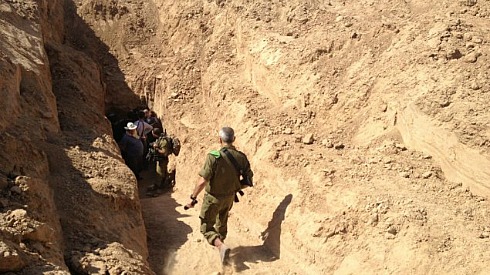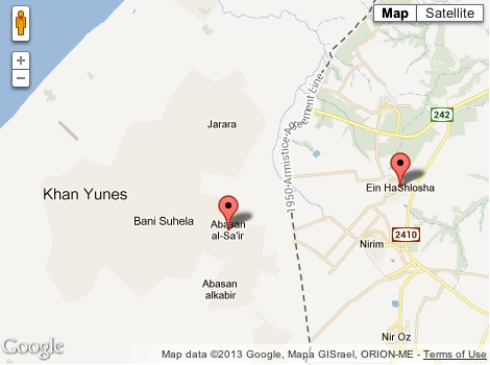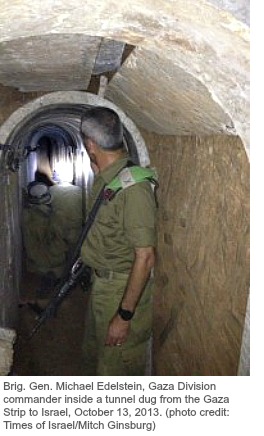Archives
AND MORE...

Intra-Terrorist Competition
_____________________

Justice, The Hamas Way
_____________________

Operation Not-Taking-It-Anymore
_____________________

Celebrating Evil
_____________________

Happy Graduation Day!
_____________________
October 13, 2013
Terror Tunnels
IDF security forces last week discovered the terminus of an extensive subterranean passageway leading from Gaza into Israel proper, near Kibbutz Ein Hashlosha in the western Negev. The tunnel was the work of Hamas, which used some 500 tons of cement earmarked for civilian building in the Strip to construct the tunnel, the IDF said (see below).
Israel’s Defense Minister Moshe Ya’alon responded immediately with a halt on the transfer of construction materials into the Strip.
We applaud Minister Ya’alon’s decision and suggest he send a few snapshots from inside the tunnel to Turkish PM Erdogan and his Gaza-flotilla cohorts.
What other country in the world is required to transfer tools and materials to those who seek to annihilate it?!
The tunnel, which began in Abbasan al-Saghira, a farming village near Khan Yunis, was 18 meters deep and 1,700 meters long and officials estimate it took around a year to construct.
Brig. Gen. Michael Edelstein, the IDF’s Gaza Division commander said the IDF was aware of exactly from which backyard the tunnel originated, and “the man who enabled it should know that he has put himself in danger.” Actually, he should be arrested immediately for aiding and abetting.
Times of Israel | October 13, 2013
IDF Blames Hamas For 'Terror Tunnel' From Gaza To Israel
Defense minister halts transfer of construction supplies to the Strip after 500 tons of cement used to construct underground passage
By Gavriel Fiske and Mitch Ginsburg

Brig. Gen. Michael Edelstein, commander of the Gaza division, entering the tunnel Sunday. (photo credit: Mitch Ginsburg/ Times of Israel staff)
An extensive subterranean passageway leading from Gaza into Israeli territory was the work of Hamas, which used some 500 tons of cement earmarked for civilian building in the Strip in the tunnel’s construction, the IDF said Sunday.
Defense Minister Moshe Ya’alon responded immediately with a halt on the transfer of construction materials into the Strip.
Security forces last week discovered the terminus of the tunnel some 300 meters inside Israel proper, near Kibbutz Ein Hashlosha in the western Negev, and took several days to render the passage unusable. The IDF said Sunday it had been aware of the tunnel effort for some time, but had not previously found its exit point.
Maj. Gen. Shlomo Turgeman, the Southern Command head, said the tunnel, “a violation of our sovereignty,” had been built using around 500 tons of cement that “Israel allowed in [to Gaza] for civilian well-being.”
The tunnel, which began in Abbasan al-Saghira, a farming village near Khan Yunis, was described by officials as being 18 meters deep and 1,700 meters long. Officials estimate it took around a year to construct.

Screenshot from BBC footage of tunnel running 1.7km (1 mile) from the Gaza Strip into Israel.
Contrary to initial media reports, the IDF said, the tunnel did not end near an Israeli kindergarten; nor was it filled with explosives.
The tunnel is a “gross violation of the ceasefire, [and is] against Israel and against the Palestinians,” said Brig. Gen. Michael Edelstein, the Gaza Division commander.
The passageway was “definitely the work of Hamas,” Edelstein added. “Hamas is clearly in difficulty, and chooses the path of terrorism. We are dealing with the same threat as the Egyptians. We act on behalf of our people and they [act] for their people,” he said.
Edelstein went on to say that the IDF was aware of exactly from which backyard the tunnel originated, and “the man who enabled it should know that he has put himself in danger.”
Abu Ubaida, a nom de guerre for the spokesperson of Hamas’s armed wing, wrote on Twitter in Arabic that “the will engraved in the hearts and minds of the men of resistance is much more important than the tunnels dug in the mud. The former will create thousands of the latter.”
The tunnel end was found on October 7, military officials said, but the discovery was only publicized a week later, on Sunday, because a search for explosives was underway. The army said an elite engineering corps was sent into the tunnel, but no explosives were found.

Eshkol Regional Council head Haim Jelin described the tunnel as “like a New York subway.” Jelin said attacks from the tunnels could prove to be more psychologically damaging to Israeli children living in communities near the border with Gaza because they could occur without warning, unlike Kassam rocket attacks from the Strip, for which advance warning is given via air defense sirens.
“The tunnel was discovered in time, and disaster was averted,” Jelin told Ynet earlier on Sunday.

Army spokesman Maj. Guy Inbar said a halt on all construction material to Gaza, announced Sunday, was enacted due to security considerations and was not meant as a punitive measure.
For years, Israel prevented the transfer of construction materials into Gaza because it said militants could use the materials to build crude rockets and explosives for attacks against Israel.
Prime Minister Benjamin Netanyahu said Sunday the discovery and neutralization of the tunnel was part of “an aggressive policy against terror… [that includes] intelligence activities, preventative measures, actions in response [to attacks] and, of course, Operation Pillar of Defense,” referring to the brief November 2012 war between Israel and Hamas.
Last Tuesday, IDF Chief Lt. Gen. Benny Gantz warned that the next war could be sparked by a “tunnel packed with explosives that reaches akindergarten.”
Alon Shuster, head of the Sha’ar Hanegev Regional Council, which borders Gaza, called on the IDF “to continue securing towns in the area and to fund security vehicles” for patrols along the Gazan border.
Netanyahu said Sunday that 2013 so far has been “the quietest [year] in more than a decade,” but noted that “we have seen an increase in terrorist activity in recent weeks.”
It was the third tunnel discovered this year. The previous two were packed with explosives, the IDF said.
Similar tunnels have been used in the past by Gazan terrorists, most notably for an attack in 2006 in which two soldiers were killed and Gilad Shalit was kidnapped.
Former national security adviser Giora Eiland, who investigated the Shalit kidnapping, said Gazan tunnels were no less a threat than the territory’s arsenal of homemade weapons.
“They have surprised us in the past with their capability of digging deep and fast,” he told Army Radio.
Tensions between Israel and Gaza have remained mostly in check since an informal ceasefire after Israel launched Operation Pillar of Defense to stem rocket fire.
On November 8, 2012, just days before launching the offensive, Israeli forces discovered a massive tunnel running out of Gaza. The forces briefly entered Gaza to search for explosives, and, on their return, while repairing the border fence, an “extremely large” amount of explosives detonated on the Gaza side of the border. One soldier was very lightly injured, and an IDF jeep was damaged by a blast that reportedly launched it 20 meters.
Analysts have noted that Gaza’s Hamas rulers, feeling the squeeze from a massive Egyptian operation to destroy smuggling tunnels into the Sinai, may seek to ignite tensions with Israel.
Times of Israel staff and AP contributed to this report.
Original article here.
Log In »
Notable Quotables
"Mr. Netanyahu is one of the most media-savvy politicians on the planet. On Friday he appeared live via video link on 'Real Time with Bill Maher,' taking the host’s alternately sardonic and serious line of questioning with gazelle-like alacrity."
~ Anthony Grant, jourrnalist who has written for many major newspapers and worked in television at Paris and Tel Aviv, interviewing former PM Benjamin Netanyahu on Monday, at the outset of Mr. Netanyahu's new book (more here).


